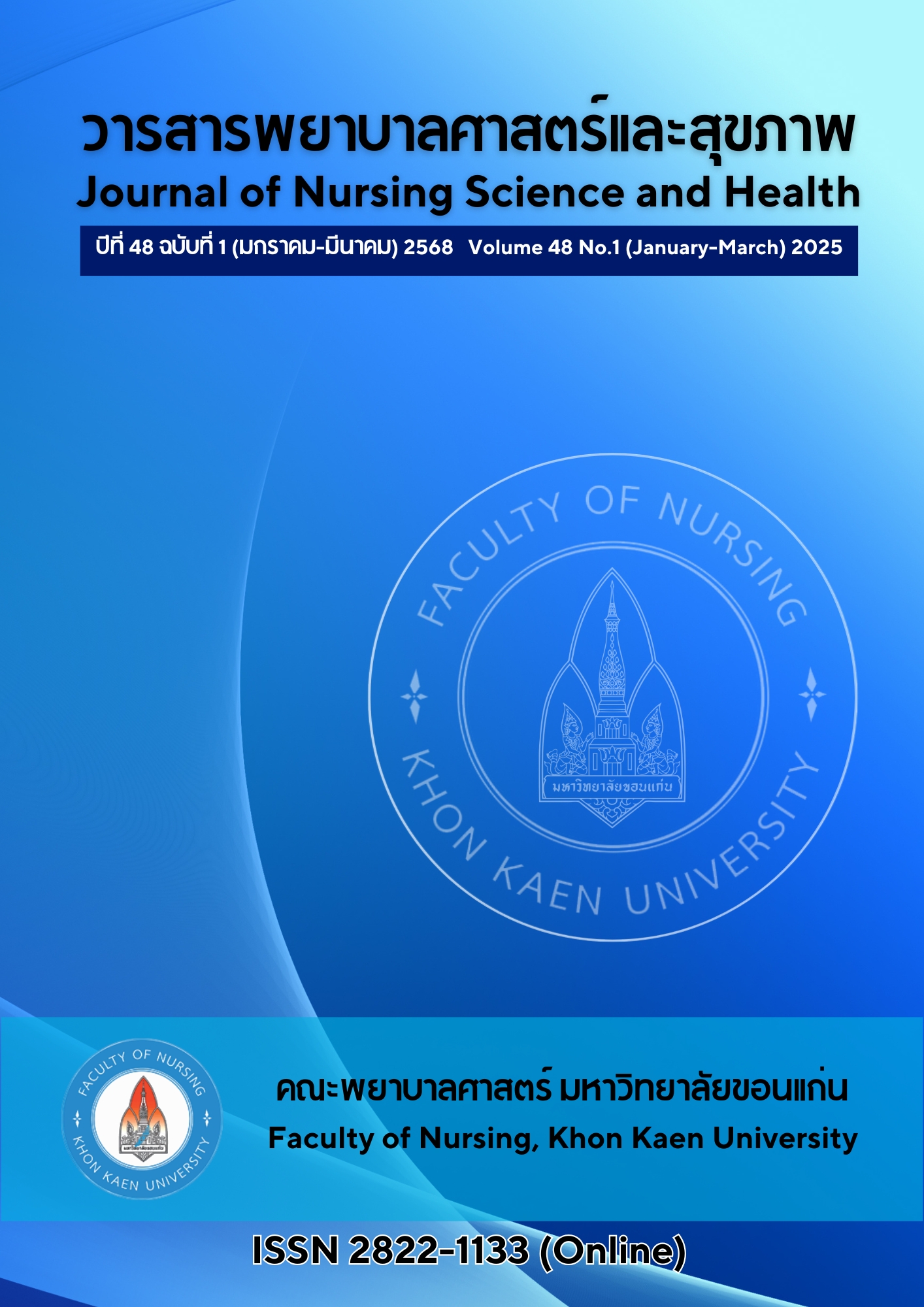ปัจจัยทำนายการเกิดการติดเชื้อในระบบทางเดินปัสสาวะ ที่สัมพันธ์กับการคาสายสวนปัสสาวะในผู้ป่วยวิกฤตอายุรกรรม
คำสำคัญ:
การคาสายสวนปัสสาวะ, ปัจจัยทำนาย, ผู้ป่วยวิกฤตบทคัดย่อ
การวิจัยเชิงทำนายแบบศึกษาไปข้างหน้า มีวัตถุประสงค์เพื่อศึกษาปัจจัยทำนายการติดเชื้อในระบบทางเดินปัสสาวะที่สัมพันธ์กับการคาสายสวนปัสสาวะในผู้ป่วยวิกฤตอายุรกรรม กลุ่มตัวอย่างคือ ผู้ป่วยวิกฤตอายุรกรรมที่ได้รับการคาสายสวนปัสสาวะที่นอนรักษาในหอผู้ป่วยวิกฤตอายุรกรรมระหว่างเดือนมกราคม ถึงเดือนเมษายน 2567 จำนวน 263 คน เก็บรวบรวมข้อมูลจากเวชระเบียนผู้ป่วย โดยใช้แบบบันทึกข้อมูลทั่วไป แบบเก็บข้อมูลปัจจัยเสี่ยงของการติดเชื้อในระบบทางเดินปัสสาวะที่สัมพันธ์กับการคาสายสวนปัสสาวะ และแบบบันทึกการวินิจฉัยการติดเชื้อในระบบทางเดินปัสสาวะที่สัมพันธ์กับการคาสายสวนปัสสาวะ วิเคราะห์ข้อมูลทั่วไปและลักษณะของปัจจัยต่าง ๆ โดยใช้สถิติพรรณนาและวิเคราะห์ปัจจัยทำนายการติดเชื้อในระบบทางเดินปัสสาวะที่สัมพันธ์กับการคาสายสวนปัสสาวะ โดยใช้สถิติการวิเคราะห์ถดถอยโลจิสติค
ผลการวิจัย พบว่า ปัจจัยทำนายการติดเชื้อระบบทางเดินปัสสาวะที่สัมพันธ์กับการคาสายสวนปัสสาวะในผู้ป่วยวิกฤตอายุรกรรม ได้แก่ ประวัติการติดเชื้อทางเดินปัสสาวะในระยะเวลา 6 เดือนที่ผ่านมา (OR=11.74 [95%CI: 1.40, 98.72] p=.023) โรคเบาหวาน (OR=4.74 [95%CI: 1.86, 12.11] p=.001) การใส่สายสวนปัสสาวะซ้ำ (OR=25.73 [95%CI: 1.69, 390.86] p=.019) จำนวนวันนอนในหอผู้ป่วยวิกฤต (OR=1.60 [95%CI: 1.32, 1.94] p<.001) ดังนั้น ทีมสุขภาพจึงควรเพิ่มความตระหนักและการเฝ้าระวัง การติดเชื้อในระบบทางเดินปัสสาวะที่สัมพันธ์กับการคาสายสวนปัสสาวะในผู้ป่วยวิกฤตอายุรกรรมที่มีประวัติ ติดเชื้อทางเดินปัสสาวะในช่วงระยะเวลา 6 เดือนที่ผ่านมา ผู้ป่วยโรคเบาหวาน ผู้ป่วยที่ได้รับการใส่สายสวนปัสสาวะซ้ำ และผู้ป่วยที่นอนในหอผู้ป่วยวิกฤตเป็นระยะเวลานาน
เอกสารอ้างอิง
Magill SS, O'Leary E, Janelle SJ, Thompson DL, Dumyati G, Nadle J, et al. Changes in prevalence of health care-associated infections in U.S. Hospitals. NEJM 2018;379(18):1732-44.
Centers for Disease Control and Prevention (CDC). Guideline for prevention of catheter-associated urinary tract infection (2009): update 2019 [Internet]. 2024 [update 2024; cite 2024 Arp 20]; Available from: https://www.cdc.gov/infectioncontrol/guidelines/ cauti/index.html
Gould CV, Umscheid CA, Agarwal RK, Kuntz G, Pegues DA. Healthcare Infection Control Practices Advisory Committee (HICPAC): guideline for prevention of catheter-associated urinary tract infections 2009 [Internet]. 2024 [update 2024; cite 2024 Arp 22]; Available from: https://www.cdc.gov/infectioncontrol/ pdf/guidelines/cauti-guidelines-H.pdf
National Healthcare Safety Network (NHSN). Urinary tract infection (Catheter-associated urinary tract infection (CAUTI) and non-catheter-associated urinary tract infection (UTI)) events [Internet]. 2024 [update 2024; cite 2024 Arp 22]; Available from: https://www.cdc.gov/nhsn/pdfs/pscmanual/7psccauticurrent.pdf
Hollenbeak CS, Schilling AL. The attributable cost of catheter-associated urinary tract infections in the United States: a systematic review. American Journal of Infection Control 2018;46(7):751-7.
Rousseau M, Goh HMS, Holec S, Albert ML, Williams RB, Ingersoll MA, et al. Bladder catheterization increases susceptibility to infection that can be prevented by prophylactic antibiotic treatment. JCI Insight 2016;1(15):e88178.
Li F, Song M, Xu L, Deng B, Zhu S, Li X. Risk factors for catheter-associated urinary tract infection among hospitalized patients: a systematic review and meta-analysis of observational studies. Journal of Advanced Nursing 2019;75(3):517-27.
Kotikula I, Chaiwarith R. Epidemiology of catheter associated urinary tract infections at Maharaj Nakorn Chiang Mai Hospital, Northern Thailand. The Southeast Asian Journal of Tropical Medicine and Public Health 2018;49(1):113-22. (in Thai)
Wongsri P, Thongmaha S. Butsing N, Skuntaniyom S, Wongprikorn A. Risk factors of catheter-associated urinary tract infection in a tertiary-care medical center. Nurs Res Inno J 2023;29(3):303-18. (in Thai)
Farsi AH. Risk factors and outcomes of postoperative catheter-associated urinary tract infection in colorectal surgery patients: a retrospective cohort study. Cureus 2021;13(5):e15111.
Letica-Kriegel AS, Salmasian H, Vawdrey DK, Youngerman BE, Green RA, Furuya EY, et al. Identifying the risk factors for catheter-associated urinary tract infections: a large cross-sectional study of six hospitals. BMJ Open 2019;9(2):e022137.
Anggi A, Wijaya DW, Ramayani OR. Risk factors for catheter-associated urinary tract infection and uropathogen bacterial profile in the intensive care unit in hospitals in Medan, Indonesia. Open Access Macedonian Journal of Medical Sciences 2019;7(20):3488-92.
Perrin K, Vats A, Qureshi A, Hester J, Larson A, Felipe A, et al. Catheter-associated urinary tract infection (CAUTI) in the neuro ICU: identification of risk factors and time-to-CAUTI using a case control design. Neurocrit Care 2021;34(1):271-8.
Assawapalanggool S, Nuankum T. Risk factors and consequences of drug-resistant urinary tract infections in Thai-Myanmar border hospitals in the northern region [Internet]. 2023 [update 2024; cite 2024 Arp 22]; Available from: https://hpc2appcenter. anamai.moph.go.th/academic/web/files/2566/preproceeding/abstract/research/61_abstract.docx
Toimamueang U, Chotikawanich E, Thepsuthammarat K. Incidence and risk factors of catheter-associated urinary tract infections in in kidney transplant recipients. Journal of Nursing and Health Care 2015;33(1);115-26. (in Thai)
Omer SA, Zahran FE, Ibrahim A, Sidahmed LA, Karam G, Almuhim F, et al. Risk factors for catheter associated urinary tract infections (CAUTI) in medical wards and intensive care units (ICU). Journal of Microbiology Research 2020;10(1):1-5.
Thungklin B, Khiewkhern O, Phitakaramwong P. Factor that affecting catheter-associated urinary tract infection among retained urinary catheter patient, inpatients department, Pichit Hospital. Phichit Hospital Journal 2017;32(2):31-41. (in Thai)
Anothayanonth Y. Factors that affecting catheter-associated urinary tract infection in tertiary hospital. JPNHS 2020;12(1):48-57. (in Thai)
Barchitta M, Maugeri A, Favara G, RielaPM, La Mastra C, La Rosa MC, et al. Cluster analysis identifies patients at risk of catheter-associated urinary tract infections in intensive care units: findings from the SPIN-UTI Network. Journal of Hospital Infection 2021;107:57-63. 20.
Ndomba ALM, Laisser RM, Silago V, Kidenya BR, Mwanga J, Seni J, et al. Urinary tract infections and associated factors among patients with indwelling urinary catheters attending Bugando medical Center a tertiary hospital in Northwestern Tanzania. Microorganisms 2022;10(2):473.
ดาวน์โหลด
เผยแพร่แล้ว
รูปแบบการอ้างอิง
ฉบับ
ประเภทบทความ
สัญญาอนุญาต
ลิขสิทธิ์ (c) 2025 วารสารพยาบาลศาสตร์และสุขภาพ

อนุญาตภายใต้เงื่อนไข Creative Commons Attribution-NonCommercial-NoDerivatives 4.0 International License.
วารสารพยาบาลศาสตร์และสุขภาพเป็นเจ้าของลิขสิทธิ์ในการเผยแพร่ผลงานที่ตีพิมพ์ห้ามผู้ใดนำบทความที่ได้รับการตีพิมพ์ในวารสารพยาบาลศาสตร์และสุขภาพไปเผยแพร่ในลักษณะต่าง ๆ ดังนี้ การนำบทความไปเผยแพร่ออนไลน์ การถ่ายเอกสารบทความเพื่อกิจกรรมที่ไม่ใช่การเรียนการสอน การส่งบทความไปตีพิมพ์เผยแพร่ที่อื่น ยกเว้นเสียแต่ได้รับอนุญาตจากวารสารพยาบาลศาสตร์และสุขภาพ



